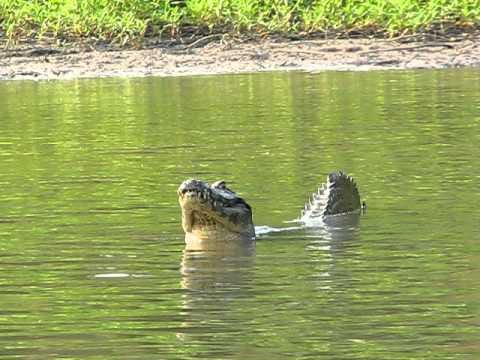One Seems to Wear Glasses
Today’s special animal friend is the caiman, three species of alligatorid reptiles – which are a subset of crocodilians – in the genus Caiman. Actually, there are six species in three genera in the subfamily Caimaninae - I wish taxonomy would settle down – but we’re only going to talk about the genus Caiman, because that’s what I decided. Common features of caimans include a wide, flat head with a rounded nose. They have a substantial brow ridge, and, when their jaws are closed, only upper teeth are visible. The largest species is the yacare caiman (Caiman yacare) can reach 9.8 feet in length. The spectacled caiman (Caiman crocodilus) grows up to 8.2 feet long, and the smallest species, at 6.6 feet, is the broad-snouted caiman (Caiman latirostris). Females are smaller than males in all the species.
This video shows the yacare caiman. According to “Crocodiles of the World,” it is found “in incredibly large populations” in the Pantanal region of Brazil. Like the American alligator, it was once hunted for its skin, but now that it is protected, it is a flourishing species. Yacare caimans are mud-colored with dark spots on their bodies and, most prominently, on their lower jaws. A feature of their dentition is that some of their lower teeth insert into holes in the upper jaw, when the jaw is closed. During the rainy season, females lay two or three dozen eggs, which hatch into little guys who will bite you. They eat snails, fish, snakes, capybaras, and other large and small prey.
The spectacled caiman is found in most of northern South America, except the Andes and the desert Pacific Coast region. They are also found throughout Central America and have been introduced to the U.S., Cuba, and Puerto Rico by pet owners. They are the most widely distributed species and are adaptable to many habitats and food sources, including mammals, fish, amphibians, crustaceans, and birds.
Spectacled caimans are very social. They use many different vocalizations, body postures, and tail movements to communicate with one another. Females lay up to 40 eggs, but usually more like 20, in mounds near the nests of other females. The females cooperate to protect the eggs from predators such as tegus lizards, coatis, and foxes. When the eggs hatch, the mothers again cooperate to guard their offspring from raptors, wading birds, snakes, and other crocodilians. Most of the young do not survive to adulthood.
The broad-snouted caiman is found in southeastern South America, including parts of Brazil, Bolivia, Uruguay, Paraguay, and Argentina. They live in marshes and floodplains, mangrove forest and flooded agricultural land, and artificial ponds and stock tanks. Their strong jaws can tear through vegetation for mobility or to capture prey. Juvenile broad-snouted caimans eat mostly insects and arachnids. As their jaws grow stronger, they begin munching turtles and snails. Full-sized adults eat a range of aquatic prey as well as birds and mammals.
The broad-snouted caiman has smoother skin than the other species. This made it very desirable for leather, and hunting was a significant threat. All the species are now protected and are rated Least Concern by IUCN. Threats include habitat loss and water quality degradation.



Good morning. It's 56 now with a high of 80 forecast. Some of the Envirothon kids are coming down with various crud. They need to recover by Friday!
“The females again cooperate to guard the offspring”, but “most of the young do not survive to adulthood.” Are the females on their phones?